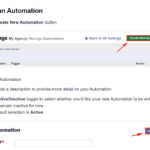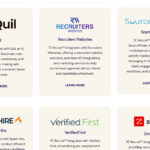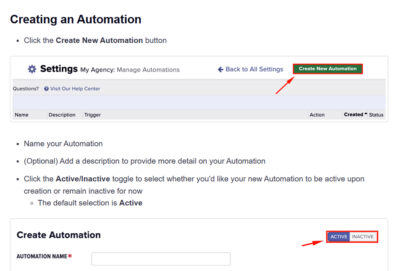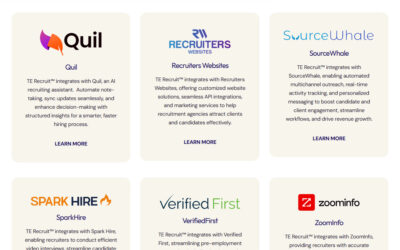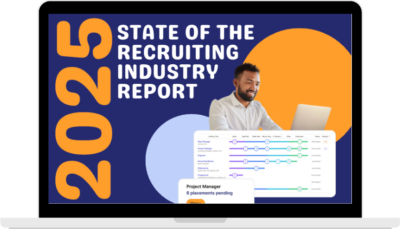(Editor’s note: The information from this article by Top Echelon Recruiting Software has been taken from an Expert Recruiter Coaching Series webinar by Gary Stauble of The Recruiting Lab titled, “Next-Gen Strategies for Referral Growth and AI-Enhanced Recruiting” Click HERE to watch the video of that training webinar for free.)
Time is the scarcest currency in recruiting. Reqs proliferate, candidates multiply, and the tools promising salvation multiply faster—but hours do not. In a deeply practical session on time management for search professionals, Gary Stauble—founder of The Recruiting Lab and host of the Recruiters Roundtable—translated 30 years of front-line experience into a system any desk can install today. What follows is an expanded, step-by-step article that squeezes every drop of signal from his talk: turn chaotic mornings into controlled momentum, reduce inbox gravity, and convert attention into interviews, revenue, and peace of mind.
“You have infinite opportunities in recruiting,” said Gary. “You do not have infinite time. The entire game is maximizing your per-hour output.”
Reality Check: Why Most Mornings Drift Off Course
Stauble opened with a quick poll. Roughly 21% of attendees rated their mornings “very effective,” while the rest ranged from “somewhat productive” to “all over the place.” That 21% figure isn’t trivia; it predicts performance.
“The people who report highly effective mornings tend to out-bill the average recruiter,” said Gary. “Morning momentum compounds.”
Why mornings matter is simple: they determine whether you control the day or your notifications do. Consider the “mid-morning panic attack” he described: snooze at 6:00 a.m., doom-scrolling the news, skipped workout, late arrival, 30 minutes “researching tools” with no next actions, and suddenly it’s 11:00 a.m. with zero calls placed. That pattern—acceptable occasionally—becomes corrosive if habitual. It erodes production, mindset, and ultimately revenue.
The Core Promise: Maximize Per-Hour Output (Not Hours Worked)
If you aim to grow from, say, $500K to seven figures, you won’t simply “work more.” You’ll extract more from each hour using leverage: system design, automation, staff, and tighter boundaries. Stauble’s counterintuitive premise:
“Increased output requires decreased input,” said Gary. “When you subtract stimuli, output climbs.”
Two stories brought this to life:
-
Nine hours in a car = a productivity windfall. With his wife driving and the dog asleep, Stauble worked from the passenger seat and finished more deep work than in a typical office day. The constraint—no options—created focus.
-
Pre-vacation productivity. The 48 hours before a phone-free trip are often a person’s most productive hours all year. Urgency and hard constraints prune the nonessential.
The takeaway: design everyday constraints so you don’t need a road trip or impending vacation to get things done.
Boundary Architecture: Fences That Create Freedom
You can’t “muscle” your way to focus with willpower alone; the attention economy is engineered against you. Instead, make focus the default.
1) Turn off all notifications by default.
Email pop-ups and red badges are mini slot machines. Add back only what you absolutely need. At minimum, kill email alerts and remove social apps from your phone.
“Environmental design beats willpower,” said Gary. “Make the right thing easy and the wrong thing invisible.”
2) Use scheduled Do Not Disturb.
Block DND during your peak periods (e.g., 9:00–11:00 a.m. and 4:00–4:30 p.m.). Publish “emergency” channels (e.g., a specific number) for truly time-critical issues.
3) The Red Bandana Rule.
A simple, visible signal (calendar status, Slack emoji, or a literal sign) that means: deep work—do not interrupt unless the building’s on fire. It sounds quaint. It works.
4) Clarify access windows.
“Best times to reach me: before 9:00, 11:00–1:00, after 4:00.” People respect fences they can see.
Inbox Detox: Stop Paying the Attention Tax
Email feels productive because it’s responsive, but it fragments attention into unusable shards. Behavioral science calls it intermittent reinforcement—the most addictive reward schedule (think slot machines). Every “new message” ping steals not just seconds but re-entry costs: the mental energy to re-immerse in deep work.
Batch your inbox into 4–6 sessions per day (e.g., 8:30, 11:00, 1:30, 3:30, 5:00). Outside those windows, your inbox is closed.
Pause inbound while sending.
Use tools or client features (e.g., Inbox Pause) so you can compose without seeing new mail. Essential when you must send something mid-block.
Snooze for follow-through.
Return-if-no-reply in X days (Boomerang-style) offloads memory. The system, not your brain, should track loops.
Touch once (as a rule).
Open email when you can decide: reply, delegate, schedule, or archive. Re-reading is time with no throughput.
“We say we’re ‘being responsive,’ but often we’re just seeking dopamine hits,” said Gary. “Batching replaces micro-dopamine with macro-progress.”
What about texts?
Batch them, too—unless an offer is in flight. DND exceptions and time-boxed message checks protect your focus while preserving responsiveness.
The Big Split: Exploration vs. Exploitation
This is the talk’s most powerful mental model.
-
Exploration is broad and novel: researching tools, reading threads, browsing LinkedIn, testing AI. It’s creative, energizing—and often detached from immediate outcomes.
-
Exploitation is narrow and output-focused: scheduling interviews, prepping submittals, screening shortlists, closing. It directly advances revenue.
Both are necessary, but don’t mix them. When exploration leaks into your morning, you feel busy and end empty.
Create an Explorer List.
When ideas pop up mid-work (a tool to try, an article to read, a sequence to test), capture them in a dedicated note (“Explore—Business” and “Explore—Personal”). Then return to the task at hand. Set a weekly Experiment Hour to evaluate 1–2 items. Standardize what pays, discard the rest.
“Exploration is jet fuel—if you keep it in a safe tank. Keep it out of your money hours,” said Gary.
Accurate Task Selection: Put the Big Rocks In First
Think of your day as a jar: sand (busywork), pebbles (mid-value tasks), rocks (priority work). If sand goes in first, there’s no room for rocks. In recruiting, it’s easy to pour sand: tool tinkering, social scrolls, admin drift.
A brutal but clarifying heuristic:
“Do the closest thing to money first.” — Peter Lefkowitz
For a desk, that translates to the three most valuable activities:
-
Schedule interviews.
-
Schedule interviews.
-
Schedule interviews.
Stauble repeated it for emphasis because it’s easy to forget. Every other activity exists to drive quality conversations between qualified candidates and quality hiring managers.
A focusing axiom to post above your monitor:
Aim for one interview per day—and whatever else you can get done by five.
You won’t hit it every day; that’s not the point. The point is clarity. When in doubt, ask: “Which next action makes today’s interview more likely?”
Build a Marketing Metronome (So Cash Flow Stops Whiplashing)
Many placements come from existing clients, which tempts recruiters to reshuffle the same deck and call it growth. The risk? You become the crocodile at a shrinking watering hole—more jaws, less water.
“You cannot negotiate from strength or curate your client list without a steady prospecting rhythm,” said Gary.
Enter the metronome: a fixed, sustainable pace for outbound.
Daily option: 5 by 10.
Complete five individual marketing actions by 10:00 a.m.—calls, one-to-one emails, or targeted LinkedIn messages to VIPs, dormant clients, or warm prospects. Not brand posts. Not general content. Real conversations.
Weekly option: dedicate a single five-hour block (e.g., Tuesdays, 9–2) for focused outbound if that keeps your motivation higher. The best system is the one you’ll adhere to.
Balance hunting (direct outreach) with farming (content, inbound). But hunting belongs in the morning rhythm, because it’s the work most people procrastinate—and it influences near-term revenue.
Time-Box the Morning, Loosen the Afternoon
Mornings set trajectory; guard them like pipeline. Use 60–90 minute “flow blocks”:
-
Block 1 (8:20–9:45): 5 by 10 + two VIP calls
-
Block 2 (10:00–11:30): candidate screens, interview scheduling, submittal prep
-
Optional Block 3 (1:00–2:30): pipeline advancement (feedback chasing, debriefs, closing steps)
Afternoons can absorb meetings, collaboration, admin, and—yes—scheduled exploration. If the morning rocks are in, you’ve already won.
“If you win the morning, you can be human in the afternoon,” said Gary.
The 4:00 p.m. Power-Down Ritual (Your Tomorrow Starts Today)
Planning tomorrow at the end of today is the single most reliable way to prevent drift. Stauble’s “Power-Down” agenda is simple and potent:
-
Review weekly goals.
Confirm that tomorrow’s actions align with outcomes you actually care about (interviews, submittals, new client touches). Weekly goals, in turn, should connect to annual targets. -
Set tomorrow’s goals (2).
Two clear wins for the day. Not ten—two. -
Select top priorities (1–3).
The big rocks. Be ruthlessly realistic. Research shows that long task lists correlate with lower completion; cap your “must-do” list at 10. -
Prep to remove friction.
Gather numbers, open the right docs, pre-write intros, build the call list. Future-you should start already in motion. -
Time-box the morning.
Put your blocks on the calendar and set Do Not Disturb to auto-enable. Let your team know when you’re reachable. -
Clear the decks.
Tie up 5-minute loose ends or push the nonessential to your Explorer List or next week.
Add a small ritual to mark completion—Stauble literally taps an “That was easy” button as he powers down. It’s goofy. It works. Brains like closure.
“We need rituals that tell the nervous system: ‘We’re done for today. Tomorrow is ready,’ said Gary.
FOMO vs. JOMO: Choosing the Joy of Missing Out
“Fear of Missing Out” convinces you that cramming more in is possible if you just optimize harder. “Joy of Missing Out” accepts a hard truth: you will miss almost everything—and that’s liberating if you choose well.
“Most items on your to-do list will never happen,” said Gary. “Take ownership of that fact and make the right things inevitable.”
Practically, JOMO means honoring caps (no more than 10 critical tasks tomorrow), selecting the rocks first, and letting the rest go on purpose. It replaces the anxiety of wishful lists with the confidence of finished ones.
Tools That Improve Adherence (Not Just Intention)
-
DND Schedules: Automate focus windows so you don’t rely on memory.
-
Inbox Pause + Send Later: Compose on your terms, release on a schedule.
-
Return-if-No-Reply: Automatic follow-through beats mental Post-its.
-
Calendar Fences: Publish office hours for questions; guard red-bandana blocks.
-
Explorer Lists: One-tap capture keeps exploration out of exploitation blocks.
If you’re a working owner, separate hats. Reserve set blocks for CEO work (hiring, finance, systems) and distinct blocks for desk production (pipelines, interviews, closes). Mixing them starves both.
Sample Daily Blueprint (Copy, Tweak, Run for 10 Days)
8:00–8:20 Power-up: scan weekly goals, confirm today’s two wins, turn on DND
8:20–9:45 Flow Block 1: 5 by 10 + two VIP calls
9:45–10:00 Log activity; snooze follow-ups (return-if-no-reply)
10:00–11:30 Flow Block 2: screens, submittals, interview scheduling
11:30–12:00 Inbox/Text Batch #2
12:00–1:00 Lunch/walk/reset
1:00–2:30 Pipeline advancement: feedback chasing, debriefs, offer prep
2:30–3:00 Inbox/Text Batch #3
3:00–4:00 Meetings/collab/admin
4:00–4:25 Power-Down (6 steps above)
4:25–4:40 Final inbox batch + schedule send-laters
4:40 Closure ritual; laptop down
Run it for two weeks. Track one metric: interviews scheduled per day. Most teams see lift within days because the morning finally points where money happens.
Rapid-Fire Q&A (Expanded)
Q: My role is service-heavy. Can I still batch email?
A: Yes—publish response windows and hold them. When you must be “live,” shorten deep-work blocks to 40–50 minutes and slot them between windows. The key isn’t perfection; it’s predictable availability plus protected production.
Q: What if an emergency arises during DND?
A: Use DND exceptions for known VIPs or keywords. Pair with an autoresponder noting when you next process messages and the channel for time-sensitive matters.
Q: I love testing tools—how do I stop it from hijacking my mornings?
A: Create an Explorer List and a weekly Experiment Hour (Friday 2–3 p.m.). Test no more than two items. Keep only what measurably improves interviews scheduled or hours saved.
Q: How many email checks are realistic?
A: Many top billers thrive at four per day. If that’s too jarring, start at six and reduce once you see the output gains.
Q: I’m a working owner. How do I separate CEO vs. producer time?
A: Try Mon/Wed/Fri mornings for desk production; Tue/Thu mornings for owner work. Afternoons flex. Protect CEO blocks as fiercely as you protect production blocks.
The System in One Page
-
Fewer inputs → more outputs.
-
Batch messages; kill notifications.
-
Explore later; exploit now.
-
Do the closest thing to money first.
-
Aim for one interview per day.
-
5 by 10 (five targeted actions by 10:00 a.m.).
-
4:00 p.m. Power-Down (plan tomorrow, prep assets, time-box, close loops).
-
Adherence over inspiration.
Do These Five Things Today
-
Disable all email notifications on desktop and phone.
-
Create two 90-minute morning blocks for the next 10 workdays and set DND to auto-enable.
-
Write “5 by 10” on a sticky note and place it on your monitor. Do it tomorrow.
-
Make two Explorer notes (“Business” and “Personal”) and capture ideas there—not in your morning.
-
Set a daily 4:00 p.m. alarm titled “Power-Down” and follow the six-step agenda.
Expect discomfort in week one—your brain misses the micro-dopamine. Expect lift by week two—more interviews, fewer scattered afternoons. By week four, expect a calmer baseline and more predictable revenue, because you’ve replaced hope with habits.
Recruiting offers infinite opportunities; time remains finite. Spend it like cash. Protect it like pipeline. And design your days so that, by 11:00 a.m., you feel momentum—not panic.


